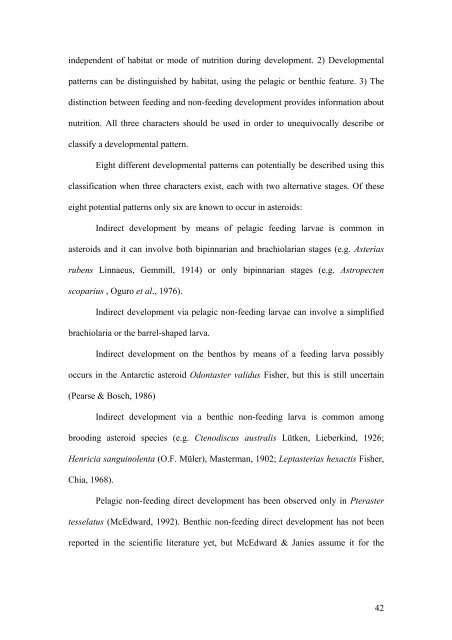Download (3398Kb) - ePrints Soton - University of Southampton
Download (3398Kb) - ePrints Soton - University of Southampton
Download (3398Kb) - ePrints Soton - University of Southampton
You also want an ePaper? Increase the reach of your titles
YUMPU automatically turns print PDFs into web optimized ePapers that Google loves.
independent <strong>of</strong> habitat or mode <strong>of</strong> nutrition during development. 2) Developmental<br />
patterns can be distinguished by habitat, using the pelagic or benthic feature. 3) The<br />
distinction between feeding and non-feeding development provides information about<br />
nutrition. All three characters should be used in order to unequivocally describe or<br />
classify a developmental pattern.<br />
Eight different developmental patterns can potentially be described using this<br />
classification when three characters exist, each with two alternative stages. Of these<br />
eight potential patterns only six are known to occur in asteroids:<br />
Indirect development by means <strong>of</strong> pelagic feeding larvae is common in<br />
asteroids and it can involve both bipinnarian and brachiolarian stages (e.g. Asterias<br />
rubens Linnaeus, Gemmill, 1914) or only bipinnarian stages (e.g. Astropecten<br />
scoparius , Oguro et al., 1976).<br />
Indirect development via pelagic non-feeding larvae can involve a simplified<br />
brachiolaria or the barrel-shaped larva.<br />
Indirect development on the benthos by means <strong>of</strong> a feeding larva possibly<br />
occurs in the Antarctic asteroid Odontaster validus Fisher, but this is still uncertain<br />
(Pearse & Bosch, 1986)<br />
Indirect development via a benthic non-feeding larva is common among<br />
brooding asteroid species (e.g. Ctenodiscus australis Lütken, Lieberkind, 1926;<br />
Henricia sanguinolenta (O.F. Müler), Masterman, 1902; Leptasterias hexactis Fisher,<br />
Chia, 1968).<br />
Pelagic non-feeding direct development has been observed only in Pteraster<br />
tesselatus (McEdward, 1992). Benthic non-feeding direct development has not been<br />
reported in the scientific literature yet, but McEdward & Janies assume it for the<br />
42
















